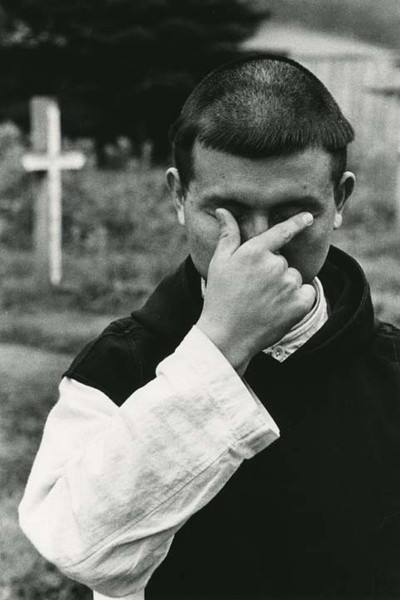Ikko Narahara
30 Mar - 28 Apr 2012

Ikko Narahara
Garden of Silence, from “Domains” 1958/1977
gelatin silver print
image size:26 x 17.2 cm
paper size:35.5 x 27.9 cm
© Narahara Ikko Archives
Garden of Silence, from “Domains” 1958/1977
gelatin silver print
image size:26 x 17.2 cm
paper size:35.5 x 27.9 cm
© Narahara Ikko Archives
IKKO NARAHARA
30 March - 28 April, 2012
Taka Ishii Photography / Film is pleased to present a two-part Ikko Narahara exhibition. The gallery will exhibit, for two weeks each, 10 photographs from two distinct bodies of Narahara’s work: The first exhibition (March 30 – April 14) will focus on portraiture, while the second (April 17 – April 28) will include Narahara’s photographs of urban landscape.
Beginning with a well received debut exhibition “Human Land” in 1956, Ikko Nakahara consistently produced photographs distinguished by their independent perspective. Under the general theme of “Sights of Civilization”, Narahara photographed a wide variety of inhabited spaces with identifiable categories such as the city and its inhabitants, monasteries and prisons. Dual Taka Ishii Gallery exhibitions will include photographs from the following series: “Human Land” (1954-57), “Domains” (1956-58), “Tokyo, the ‘50s” (1954-58), “Blue Yokohama” (1960), “Where time has stopped” (1963-65), “Venice - Nightscapes” (1964-85), “Where time has vanished” (1971-72), and “Broadway” (1973-74). By presenting first Narahara’s work in portraiture and subsequently his photographs of place, the gallery intends to create a space in which the broad scope of his practice is evident.
Ikko Narahara was born in 1931 in Fukuoka, Japan. As a child, he lived an uprooted existence, his family constantly moving together with his oft-transferred father. Narahara’s interest in art photography began in 1946. Upon graduating from Chuo University in 1954, he enrolled in a Masters program at Waseda University Department of the Arts (Art History) and in 1955 joined “Jitsuzaisha (Real Existence)”, an avant-garde painting group together with Masuo Ikeda and Ay-O. At this time, Narahara socialized with artists such as Tatsuo Ikeda and On Kawara as well as Shuzo Takiguchi. During the same period, he met Shomei Tomatsu, Eikoh Hosoe, and together they set up an independent agency named “VIVO” (1961). He thereafter continued to create work in photography while at the same time actively engaging with creators irrespective of a specific media. Ikko Nakahara’s work appeals through its elusiveness, an unwillingness to maintain a singular shape or form.
30 March - 28 April, 2012
Taka Ishii Photography / Film is pleased to present a two-part Ikko Narahara exhibition. The gallery will exhibit, for two weeks each, 10 photographs from two distinct bodies of Narahara’s work: The first exhibition (March 30 – April 14) will focus on portraiture, while the second (April 17 – April 28) will include Narahara’s photographs of urban landscape.
Beginning with a well received debut exhibition “Human Land” in 1956, Ikko Nakahara consistently produced photographs distinguished by their independent perspective. Under the general theme of “Sights of Civilization”, Narahara photographed a wide variety of inhabited spaces with identifiable categories such as the city and its inhabitants, monasteries and prisons. Dual Taka Ishii Gallery exhibitions will include photographs from the following series: “Human Land” (1954-57), “Domains” (1956-58), “Tokyo, the ‘50s” (1954-58), “Blue Yokohama” (1960), “Where time has stopped” (1963-65), “Venice - Nightscapes” (1964-85), “Where time has vanished” (1971-72), and “Broadway” (1973-74). By presenting first Narahara’s work in portraiture and subsequently his photographs of place, the gallery intends to create a space in which the broad scope of his practice is evident.
Ikko Narahara was born in 1931 in Fukuoka, Japan. As a child, he lived an uprooted existence, his family constantly moving together with his oft-transferred father. Narahara’s interest in art photography began in 1946. Upon graduating from Chuo University in 1954, he enrolled in a Masters program at Waseda University Department of the Arts (Art History) and in 1955 joined “Jitsuzaisha (Real Existence)”, an avant-garde painting group together with Masuo Ikeda and Ay-O. At this time, Narahara socialized with artists such as Tatsuo Ikeda and On Kawara as well as Shuzo Takiguchi. During the same period, he met Shomei Tomatsu, Eikoh Hosoe, and together they set up an independent agency named “VIVO” (1961). He thereafter continued to create work in photography while at the same time actively engaging with creators irrespective of a specific media. Ikko Nakahara’s work appeals through its elusiveness, an unwillingness to maintain a singular shape or form.
